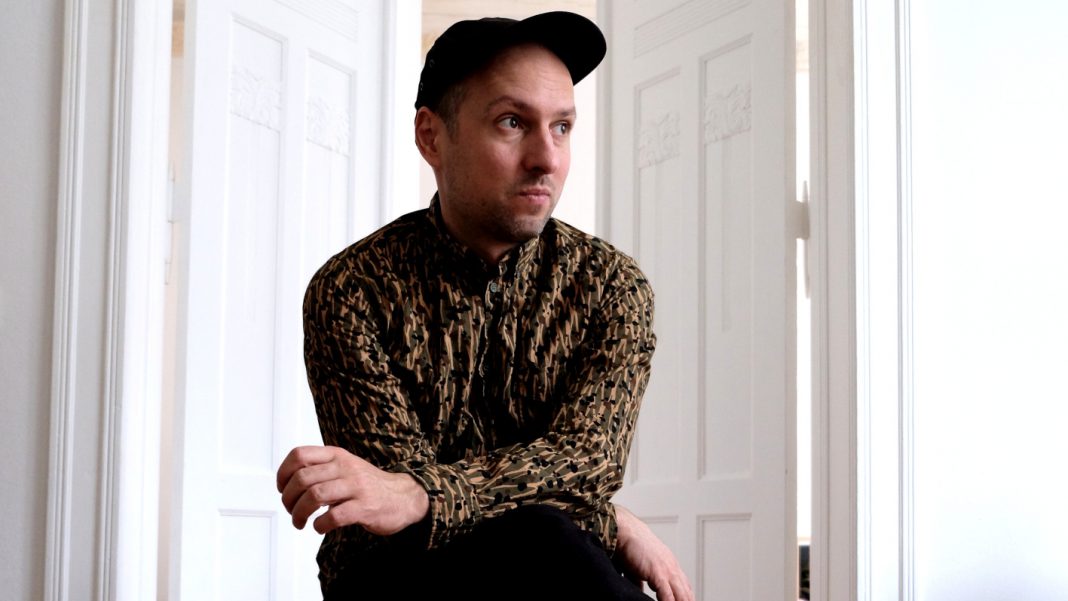
Photo: Press (Stefan Goldmann)
Stefan Goldmann has five or six ideas he’s working on, he says in our interview, and that is probably a conservative estimate. For about two decades now, the Macro co-founder has been pushing the envelope with (fast) forward-thinking music that ranges from the highly conceptual and electroacoustic to straight-up banging and club-ready. Having unfortunately relased his last EP Tears Of Joy at a rather not-so-joyful time for the latter category, his upcoming album Live At Philharmonie Berlin, recorded early this year, draws on ideas and concepts developed over the past few years. And Goldmann’s mix for our Groove podcast? Has 28 or more ideas in it.
First off, how have you been doing in the past months?
Surprisingly well. I miss friends which I haven’t seen lately. I miss some places I tended to visit regularly. However, I’ve also had a chance to be closer to those who matter the most to me, and I’ve also had time to be close to some ideas without most of the usual interruptions. That’s priceless. I’ve never believed in prioritising touring over everything else, thus I probably was well prepared for facing the challenge of zero touring. Still, under the usual routine you tend to pile up stuff you’d like to do but you never get around to actually do it. Now’s that time.
With last year’s LP Veiki, you were working with irregular metres within the framework of techno music in order to „resolve the problem of how to bring the tools and traits of cutting edge electronic music to alternative traditions of music, or vice versa.“ Why does this problem exist at all?
Not problems, but possibilities. There are more timeless ideas brought down through the generations than we currently employ. What was amazing about techno is that it offered a set of methods that could be applied anywhere by anyone. Yet after 35 years one may ask the question if the same set of fundamental ideas which keep being replicated around the globe really represent all there is. Just like the originators of techno built on existing technology and received ideas and melded them into something pretty powerful, why not look into other sets of cultural inputs? Culturally progressive people across the globe have sidelined their local cultural base in order to participate in something that overcomes boundaries. I’ve loved the universality this creates a lot – the level playing field of concepts which ultimately belong to all, the symbolism of overcoming all tradition and dancing with the machines. This still draws people in, but in terms of developing ideas it appears to have hit a wall lately. Thus we can maybe break it up a little again. That’s what I’ve been interested in.
You’ve just returned from an artist residency in Greece. What were you working on there?
It was one of the few meaningful ways to currently travel on behalf of music. I was looking into options to expand on the concepts behind Veiki. Whereas the specific rhythms I used for the album came in their Bulgarian versions – a culture I’m pretty familiar with – the same rhythmic structures occur all over Southeastern Europe, the Eastern Mediterranean and beyond. I was particularly looking into the Greek varieties here, collecting patterns for future reference. It’s a bit like with food. Greek and Bulgarian food is very similar, but Bulgaria grows no olives and hence there’s no olive oil in the cuisine. In Greece you often find oregano in the food, in Bulgaria the main herb is savory. These differences give everything a little twist, despite otherwise looking at the same dish. It’s similar with the assymetrical rhythms in practice. They are essentially the same, but with a little different flavour of where you put the emphasis or how you phrase things.
Your last EP Tears of Joy was released on the 13th of March in a time when from one day to the other, clubs closed all over the world. Just a month before, you said in an interview that „if you produce music that falls into a functional genre such as techno, there’s usually also an infrastructure in place that brings it to the people.“ Which effect, economic and otherwise, did it have when suddenly that infrastructure was not there anymore?
Yeah, once I do a record that’s straight up dance floor fodder and the world decides to put us all into isolation. It came out the moment at which everything went into shutdown and thus it fell through entirely. Within a week everybody went into full paralysis – DJs, music journalists, record shops… Luckily I had some months to test these tunes, so at least I have the gratification to know how they felt in some previous state of the world.
Tears of Joy was released through Macro, the label you run together with Finn Johannsen, and was followed in late September by a L’estasi Dell’oro mini LP. While its sound is decidedly leftfield, also this record can be categorised as techno. What aesthetic potential do you see in a type of music that generally aims to soundtrack social experiences that are currently so hard to come by?
I don’t think that music aims at soundtracking social experiences, which it can hardly be aware of in advance. I think it’s exactly the other way around: social experiences attach themselves to music that happens to fall into place, usually by accident and sometimes with a delay of a few decades. I’d even go further and state that the music which has the biggest social impact tends to be the one with the least clue of what it will end up meaning to people. By contrast, music that tries to track the mood of the day neither tends to be particularly important nor memorable. Maybe that’s because the most memorable moments of our lives also tend to be those that disrupted our expectations the most. As far as Macro is concerned, we try to look at a time horizon that extends beyond next week. I have some records which I released almost twenty years ago and only a decade later a real audience shaped up for them. My own DJ sets include tracks that cover a timespan from thirty years old to unreleased. Finn’s range is even wider. Thus we’re pretty unflustered in terms of immediate social gratification. We accumulate. Just put stuff into the void and wait for it to fill, really.
Macro was described by you as a „boutique label“ after you had started it and has been a hub for unusual club music by the likes of KiNK, rRoxymore or Vladimir Dubyshkin and more adventurous and conceptual music, like Maria Chavez’s recent reinterpretation of your Ghost Hemiola vinyl release that contained empty locked grooves on two 12″s. What would you say is the lowest common denominator between those records, what makes a Macro record a Macro record?
Lowest? I tend to think we identify ideas that are not already floating around freely and give them an outlet. The limits usually are that we need to be competent in evaluating what we are releasing, so that excludes quite a bit. For the same reason there’ll usually be some relation to the repertory of formal traits of techno, such as grids, loops, sampling or even just vinyl culture. Another way to put it is that we sometimes miss something in current culture and if we happen to find it we’ll happily release it.
Next up on Macro is an album with your live concert at this year’s STROM festival, recorded at the Philharmonie Berlin – the first time this venue hosted such an event. What was the concept behind your A/V performance there?
To me the Philharmonie’s grand hall is one of the world’s most gratifying spaces, acoustically as well as visually. Hence the A/V format felt most appropriate, engaging the unique geometry visually and addressing its acoustic sweetspots musically. Javier Benjamin was responsible for developing the visuals. We had worked together before for concerts at Mutek and CCK in Buenos Aires, as well as at Radialsystem in Berlin. Javier employs spectral and dynamic analyses of the music in real time, then linking those individual data streams to control the dimensions and movements of visual objects or to push growth patterns in directions governed by the music. Thus his work is very abstract and organic, but also obviously connected to what you hear at the same time. On my end, I used the opportunity to present what you could call a retrospective of my work so far, yet through new compositions. This means I went through the formal systems which I have developed over the years and welded them all together into interlocking entities. The resulting integration across different parameters can be best explained with a track here which is called „Builders“. In it each tone has a simple repetition pattern, each in a different tempo, creating a dense net of pitch-dependent rhythms. There is what could be described as an invisible object to which rhythm, pitch, and a few other parameters are bound. When this „object“ is thrown around in its hidden space, the tones and patterns are dragged along, other sounds are set off when specific points get struck – you can follow the movements indirectly and get an idea of the shape of this separate virtual space while the sound is blown into the very real angular auditorium of the Philharmonie. What you get is first and second order site-specific work, folded into one.
What was the idea behind your contribution to our Groove podcast?
I’ve tried to cover a bit of a range and travel the wide arc – to keep moving gradually for the longest part instead of quickly locking into some particular level of energy. There are also a lot of tracks I find interesting or keep getting back to but didn’t get to deploy too much over the last year. Probably because I was mostly playing slots where going in at a different energy level felt right.
Last but not least: what are your plans for the future?
I have another five or six ideas I wanna work on. The rest we’ll see.
Stream: Stefan Goldmann – Groove Podcast 276
01. Aisha Devi: Intentional Dreams (Houndstooth)
02. Aleksi Perälä: GBBVT1337082 (AP Musik)
03. Ruff Cherry: Mysterians (Midgar)
04. Akkord: XMTR (Houndstooth)
05. Nkisi: Human Condition (Doomcore)
06. Roman Flügel: Vegetarian Leather Jackets (Hypercolour)
07. Debby Friday: Void (Debby Friday)
08. Roman Flügel: Stuffy / SG edit (Dial)
09. Laurel Halo + Hodge: Tru (Livity Sound)
10. Bernard Badie: Move To The Beat (Mojuba)
11. MAW: All Night (I Can Do It Right) (West End)
12. Willie Ninja: Hot – Danny Tenaglia Remix (Nervous)
13. Lil Louis: I Called U (Epic)
14. Softcoresoft: Small and Slow (Sweet Equity)
15. Dold: Misogynist Comments In Cyberspace (Arsenik)
16. Somewhen: Ecsit (Sana)
17. Nyra: Eternal Ends (E-Beams)
18. Blawan: Many Many Pings (Ternesc)
19. Surgeon: The Etheric Body (Dynamic Tension)
20. Eris Drew: Trans Love Vibration (Naive)
21. AGF: Cognitive Modules Party – HVL edit (AGF)
22. Cowboy Rhythmbox: Shake (Comeme)
23. Aiken: Potential (Non Series)
24. Stef Mendisidis: Operator (Projekts)
25. Nkisi: Pilli Pilli / SG edit (Nkisi)
26. Oisel: Eliosfera (Arsenik)
27. Barker: Cascade Effect (Ostgut Ton)
28. Objekt: Secret Snake (PAN)
![[REWIND 2025]: Die Top 5 der Autor:innen](https://groove.de/wp-content/uploads/2025/12/rewind-2025-die-top-5-der-autorinnen--218x150.jpg)


![[REWIND 2025]: Kuratorin Charlotte Knaup über Berlin Beats im Hamburger Bahnhof: „Da gibt es so viel Raum, so viel Luft und so viel Reibung, die wir uns anschauen wollen”](https://groove.de/wp-content/uploads/2025/12/Berlin-Beats_Charlotte-Knaup-als-Kuratorin-vom-Hamburger-Bahnhof-218x150.jpg)
